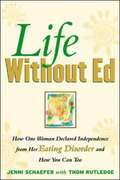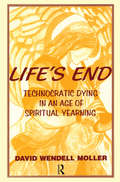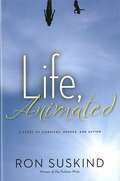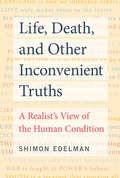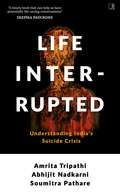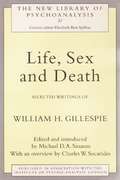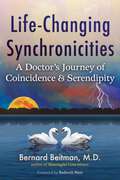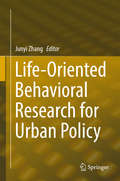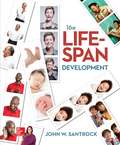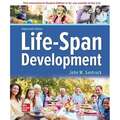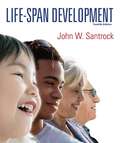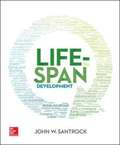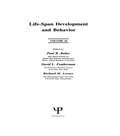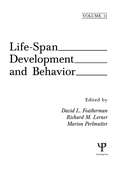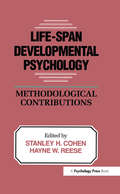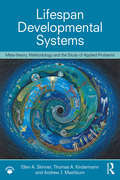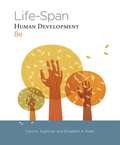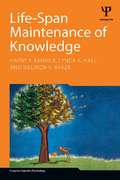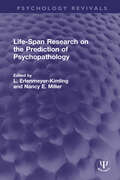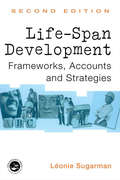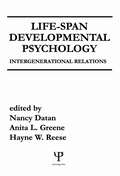- Table View
- List View
Life within Hidden Worlds: Psychotherapy in Prisons (The Forensic Psychotherapy Monograph Series)
by Jessica Williams SaundersThroughout most of human history, our ancestors have done rather poorly when dealing with acts of violence. To cite but one of many shocking examples, let us perhaps recall a case from 1801, of an English boy aged only 13, who was executed by hanging on the gallows at Tyburn. What was his crime? It seems that he had been condemned to die for having stolen a spoon (Westwick, 1940).
Life without Ed: How One Woman Declared Independence from Her Eating Disorder and How You Can Too
by Jenni Schaefer Thom RutledgeJenni shares the long, difficult and continuing process of recovery from an eating disorder. In therapy with Thom (her co-author for this book), she learns to conceptualize her eating disorder as something outside of herself; she calls him Ed and likens her battle to overcome this external and destructive force to that of a woman struggling to overcome the damaging effects of having an abusive partner. Jenni shares her experiences in short, easy-to-read vignettes, while Thom shares exercises people can use in their recovery. Both authors emphasize building a strong support team.
Life's End: Technocratic Dying in an Age of Spiritual Yearning
by David Wendell MollerThe explicit purpose of this book is to analyze dying and death in the cosmopolitan, modern setting. There is, however, an additional theme that is implicit in the analysis and observations. The portrait of dying, which is provided in the pages of the book, also tells us a great deal about life. It demonstrates that the foundation for the medicalization of death that piercingly shapes the life experience of dying persons and loved ones is a product of the ways of life in the broader culture.
Life's a Campaign: What Politics Has Taught Me About Friendship, Rivalry, Reputation, and Success
by Chris MatthewsChris Matthews is like no other TV interviewer. Life's a Campaign is like no other book on success. Famous for demanding the truth from his Hardball guests, Chris Matthews now reveals what the people running this country rarely confess: the secrets of how they got to the top. Here is the first book on power with insight snatched from those who wield it. Life's a Campaign exposes the tactics, tricks, and truths that help people get ahead-and can help you, too, whatever your field of ambition. Written in the assertive, good-natured style that is Matthews's trademark, Life's a Campaign is the most useful kind of investigative reporting. You'll benefit from his insider's scrutiny of the Congress, the White House, and the national news media. Here are the methods, showcased in fascinating anecdotes and case histories, that presidents, senators, and other powerful people use to persuade others and win--and the life lessons they provide for the rest of us. You'll learn about Bill Clinton's laser-focused ability to listen to those he wants to seduce--and how he's been teaching that craft to his wife, Hillary; how Ronald Reagan employed his basic optimism to win history to his side; the simple steps in human diplomacy that the first President Bush exploited to assemble a worldwide posse to attack Saddam Hussein and gain global approval in a way his son has failed to do; how Nancy Pelosi became the first woman Speaker of the House by practicing the most fundamental of human qualities: hard-nosed loyalty. You'll also find out, for the first time, about Matthews's own wild ride through the turbulent, converging rapids of politics and journalism. The big payoff in Life's a Campaign is what you'll learn about human nature: * People would rather be listened to than listen. * People don't mind being used; what they mind is being discarded. * People are more loyal to the people they've helped than the people they've helped are loyal to them. * Not everyone's going to like you. * No matter what anybody says, nobody wants a level playing field. Knowing such truths is the successful person's number one advantage in life. As you'll learn in Life's a Campaign, mastering--and employing--these truths separates the leaders from the followers.
Life, Animated: A Story of Sidekicks, Heroes and Autism
by Ron SuskindWhat if you were trapped in a Disney movie? In all of them, actually from Dumbo to Peter Pan to The Lion King -- and had to learn about life and love mostly from what could be gleaned from animated characters, dancing across a screen of color? Asking this question opens a doorway to the most extraordinary of stories. It is the saga of Owen Suskind, who happens to be the son of one of America's most noted writers, the Pulitzer Prize-winning journalist and author Ron Suskind. He's also autistic. The twisting, 20-year journey of this boy and his family will change that way you see autism, old Disney movies, and the power of imagination to heal a shattered, upside-down world.
Life, Death, and Other Inconvenient Truths: A Realist's View of the Human Condition
by Shimon EdelmanAn expert on happiness presents an engaging and inspiring guide to making sense of the human condition via brief essays on concepts from action, to love, to thought, to youth.This book offers a guide to human nature and human experience--a reference book for making sense of life. In thirty-eight short, interconnected essays, Shimon Edelman considers the parameters of the human condition, addressing them in alphabetical order, from action (good except when it's not) to love (only makes sense to the lovers) to thinking (should not be so depressing) to youth (a treasure). In a style that is by turns personal and philosophical, at once informative and entertaining, Edelman offers a series of illuminating takes on the most important aspects of living in the world.
Life, Interrupted: Understanding India's Suicide Crisis
by Amrita Tripathi Dr Abhijit Nadkarni Dr Soumitra Pathare"A timely book that can help us have potentially life-saving conversations" - DEEPIKA PADUKONE, Actor & Founder, LiveLoveLaugh&“A shocking fact and huge wake-up call is that suicide is the leading cause of death for young Indians. As a country — across all our expertise and fields of interest — we need to pay closer attention, and this book urges us to do just that, with clear policy level suggestions and a call to action.&” -ABHINAV BINDRA In India we tend to have a fatalistic attitude towards suicide, tending to believe that nothing can be done to prevent it, focusing only on the politically volatile issue of farmer suicides, or periodically, when there is a death by suicide of a prominent personality or suicides in vulnerable groups (for example, students especially after Board exam results), there is a hue and cry in the popular press with opinion makers demanding immediate action.Why should you care? Because a disproportionate number of young Indians die by suicide and these are preventable deaths.The resulting knee-jerk reaction from policymakers is to offer some immediate solutions (appointing counsellors in colleges, etc.) which have little evidence of success. After a while, everyone forgets the issue, until the next such event and the cycle repeats itself.This book aims to present evidence-based strategies to tackle suicide, using interviews, case studies and conversations that lay readers can make sense of, while proposing an outline of steps that policymakers, journalists and key stakeholder groups can collaborate on to provide better solutions and save precious lives in India.
Life, Sex and Death: Selected Writings of William Gillespie (The New Library of Psychoanalysis)
by Michael D.A.SinasonA distinguished and revered elder of the British Psycho-Analytical Society, Dr William Gillespie is one of the few British psychoanalysts who began training in the Vienna of the early 1930s. Later he became well known in England for his pioneering studies of sexual perversion, and for his views on female sexuality, regression in old people facing death, and on instinct theory. William Gillespie is celebrated not only for his scientific contributions but also for his administrative skill, integrity and tact in managing the International Psycho-Analytical Association and the British Psycho-Analytical Society, where he was trusted and respected by both Melanie Klein and Anna Freud. In a biographical introduction the editor, Dr Michael Sinason, looks back on the productive 90 years of Gillespie's life, writing movingly of his early life in China and Scotland and showing his development as a psychoanalytic thinker, organizer and administrator, husband and father. Dr Charles Socarides, an American psychoanalyst eminent in the field of perversion and its treatment, discusses the innovations introduced by each of the papers in the collection shows how Gillespie's ideas influenced by his own contributions and affected the field as a whole.
Life-Changing Synchronicities: A Doctor's Journey of Coincidence and Serendipity
by Bernard Beitman• Tells the author&’s personal stories of unlikely coincidences, showing how synchronicity can be identified and evolve in one&’s own life• Explores how recognizing synchronicity and serendipity can help individuals find their life purpose, accelerate their spiritual and interpersonal development, and positively impact their lives• Builds on the work of Carl Jung on the significance of synchronicityIn Life-Changing Synchronicities, pioneering psychiatrist Bernard Beitman, M.D., explores the experience and ramifications of meaningful coincidences, including how synchronistic happenings came to define his own life. Building on Carl Jung&’s groundbreaking work on this phenomenon, Beitman applies new insights on coincidence, synchronicity, serendipity, and related phenomena to the contemporary age, ultimately helping readers begin to better identify patterns of synchronicity in their own lives, find deeper meaning, and more consciously align with their personal life path and goals.The unlikely trajectory of the author&’s own life reveals the strange and counterintuitive nature of synchronicity. From Wilmington, Delaware, to 1960s-era San Francisco, Beitman explores his experience with precognition and telepathy while playing high school football, his life as a psychiatric medical school student and hippie in Haight-Ashbury, and his rise to become head of psychiatry at University of Missouri-Columbia Medical School while developing The Coincidence Project. As well as providing questions for readers to reflect on, throughout the book Beitman provides additional tools to illustrate synchronicity, offering insightful comments and principles in each section to synthesize useful reflections that serve as a guide for readers&’ own "coincidence diaries."
Life-Oriented Behavioral Research for Urban Policy
by Junyi ZhangThis book presents a life-oriented approach, which is an interdisciplinary methodology proposed for cross-sectoral urban policy decisions such as transport, health, and energy policies. Improving people's quality of life (QOL) is one of the common goals of various urban policies on the one hand, while QOL is closely linked with a variety of life choices on the other. The life-oriented approach argues that life choices in different domains (e. g. , residence, neighborhood, health, education, work, family life, leisure and recreation, finance, and travel behavior) are not independent of one another, and ignorance of and inability to understand interdependent life choices may result in a failure of consensus building for policy decisions. The book provides evidence about behavioral interdependencies among life domains based on both extensive literature reviews and case studies covering a broad set of life choices. This work further illustrates interbehavioral analysis frameworks with respect to various life domains, along with a rich set of future research directions. This book deals with life choices in a relatively general way. Thus, it can serve not only as a reference for research, but also as a textbook for teaching and learning in varied behavior-related disciplines.
Life-Span Development
by John SantrockAs a master teacher,John Santrock connects students to current research and real-world application,helping students see how developmental psychology plays a role in their ownlives and future careers. Through an integrated, personalized digital learningprogram, students gain the insight they need to study smarter and improve performance.
Life-Span Development
by John SantrockAs a master teacher, John Santrock connects current research with real-world application, helping students see how developmental psychology plays a role in their own lives and future careers. Through an integrated learning goals system, this comprehensive and chronological approach to lifespan development helps students gain the insight they need to study smarter, stay focused, and improve performance.
Life-Span Development (12th edition)
by John W. SantrockPrevious editions of this text have been widely adopted for their accurate, complete, and up-to-date coverage. While maintaining these hallmarks, this revision includes increased coverage of adulthood and aging, a new Interlude feature on applications, and updated research with more 21st-century citations.
Life-Span Development (15th Edition)
by John W. SantrockThe book intends to provide students with the best and most recent theory and research in the world today about each of the periods of the human life span and guide them in making developmental connections across different points in the human life span.
Life-Span Development and Behavior: Volume 10 (Life-Span Development and Behavior Series #Vol. 12)
by Richard M. Lerner David L. Featherman Paul B. BaltesThis serial publication continues to review life-span research and theory in the behavioral and social sciences, particularly work done by psychologists and sociologists conducting programmatic research on current problems and refining theoretical positions. Each volume introduces excellent peer-reviewed empirical research into the field of life-span development while presenting interdisciplinary viewpoints on the topic. Often challenging accepted theories, this series is of great interest to developmental, personality, and social psychologists.
Life-Span Development and Behavior: Volume 11 (Life-Span Development and Behavior Series #Vol. 12)
by Richard M. Lerner David L. Featherman Marion PerlmutterThis volume continues the tradition of the Life-Span Development Series, presenting overviews of research programs on a variety of developmental topics. Research and theory in life-span development have given increased attention to the issues of constancy and change in human development and to the opportunities for, and constraints on, plasticity in structure and function across life. Acknowledging the need for and existence of interconnection between age and developmental periods, it focuses on conditions for possibly discontinuous development that emerge at later periods. Contributors to this series are sensitive to the restrictive consequences of studying only specific age periods, such as old age, infancy, or adolescence. Each scholar attempts to relate the facts about one age group to similar facts about other age groups, and to move toward the study of transformation of characteristics and processes over the life span.
Life-Span Development and Behavior: Volume 12 (Life-Span Development and Behavior Series #Vol. 12)
by Richard M. Lerner David L. Featherman Marion PerlmutterThe final volume in this significant series, this publication mirrors the broad scientific attention given to ideas and issues associated with the life-span perspective: constancy and change in human development; opportunities for and constraints on plasticity in structure and function across life; the potential for intervention across the entire life course (and thus for the creation of an applied developmental science); individual differences (diversity) in life paths, in contexts (or the ecology) of human development, and in changing relations between people and contexts; interconnections and discontinuities across age levels and developmental periods; and the importance of integrating biological, psychological, social, cultural, and historical levels of organization in order to understand human development.
Life-Span Developmental Psychology: Methodological Contributions
by Stanley H. Cohen Hayne W. ReeseDealing with the methodological and data analytic problems in developmental research, this book presents solutions advanced from the disciplinary perspectives of psychology, behavior analysis and behavioral systems, sociology, and anthropology. Topics addressed include: * the metatheoretical issues about the relationship between data and theory * the identification and analysis of age, cohort, and time-of-measurement effects * the assessment of quantitative and qualitative change * the use of group and single-subject designs for control by systematic variation * the use of systems methodology to investigate the developmental continuity and organization of behavior * the analysis of data from repeated measures designs * the use of structural equations and path analysis to test causal hypotheses * the use of structured relational matrices to study development and change This unique volume offers students an unusually wide range of research tools for identifying and studying specific developmental problems.
Life-Span Developmental Systems: Meta-theory, Methodology and the Study of Applied Problems
by Ellen A. Skinner Thomas Kindermann Andrew MashburnEverything you always wanted to know about theories, meta-theories, methods, and interventions but didn’t realize you needed to ask. This innovative textbook takes advanced undergraduate and graduate students "behind the curtain" of standard developmental science, so they can begin to appreciate the generative value and methodological challenges of a lifespan developmental systems perspective. It envisions applied developmental science as focused on ways to use knowledge about human development to help solve societal problems in real-life contexts, and considers applied developmental research to be purpose driven, field based, community engaged, and oriented toward efforts to optimize development. Based on the authors’ more than 25 years of teaching, this text is designed to help researchers and their students intentionally create a cooperative learning community, full of arguments, doubts, and insights, that can facilitate their own internal paradigm shifts, one student at a time. With the aid of extensive online supplementary materials, students of developmental psychology as well as students in other psychological subdisciplines (such as industrial-organizational, social, and community psychology) and applied professions that rely on developmental training (such as education, social work, counseling, nursing, health care, and business) will find this to be an invaluable guidebook and toolbox for conceptualizing and studying applied problems from a lifespan developmental systems perspective.
Life-Span Human Development (Eighth Edition)
by Carol K. Sigelman Elizabeth A. RiderKnown for its clear, straightforward writing style, comprehensive coverage, strong and current research-based approach, and excellent visuals and tables, this life-span development text offers a topical organization at the chapter level and a consistent chronological presentation within each chapter. Each chapter focuses on a domain of development such as physical growth, cognition, or personality, and traces developmental trends and influences in that domain from infancy to old age. Within each chapter, you will find sections on four life stages: infancy, childhood, adolescence, and adulthood. This unique organization enables students to comprehend the processes of transformation that occur in key areas of human development. Another staple of the text is its emphasis on theories and how they apply to specific topics in each chapter. This new edition also asks students to engage more actively with the content, and includes a clear focus on the complex interactions of nature and nurture in development, more integrated coverage of culture and diversity, and an exciting new media package for both students and instructors.
Life-Span Human Development (Ninth Edition)
by Carol K. Sigelman Elizabeth A. RiderKnown for its clear, straightforward writing style, grounding in current research, and well-chosen visuals and examples, Sigelman and Rider's text combines a topical organization at the chapter level and an age/stage organization within each chapter. Each chapter focuses on a domain of development such as physical growth, cognition, or personality and traces developmental trends and influences in that domain from infancy to old age. Each chapter also includes sections on infancy, childhood, adolescence, and adulthood. The organization helps you grasp key transformations that occur in each period of the life span. Other staples of the text are its emphasis on theories and their application to different aspects of development and its focus on the interplay of nature and nurture in development. This edition includes new research on biological and sociocultural influences on life-span development and offers new media resources that help you engage more actively with the content.
Life-Span Maintenance of Knowledge (Essays in Cognitive Psychology)
by Harry P. Bahrick Lynda K. Hall Melinda K. BakerThis volume describes how well we maintain the knowledge we acquire throughout life. Research traditionally focuses on memory for events that are retained over short time periods that can be accommodated in experiments. This book, by contrast, uniquely describes the evolution of methods suitable for investigating memory of complex knowledge acquired over several years and retained during the entire life-span. The methods substitute statistical for experimental controls, and the investigations involve several hundred participants whose memory is tested up to 50 years after they acquired the knowledge in question. The book covers educational content, such as mathematics and foreign languages; knowledge acquired incidentally, such as the streets and buildings of the cities in which we live; and knowledge acquired through the media. Previously unpublished research on age-related access to knowledge is included. The analyses are based on the accessibility/availability ratio, a metric presented for the first time. This metric allows comparisons of the portion of available knowledge that can be recalled as a function of age, education and other individual differences, and as a function of the domain of knowledge in question. The ratio can be used to evaluate methods of instruction and methods of studying. It can also be used to evaluate memory development and to diagnose memory pathology. The volume will be of interest to researchers in human memory, developmental psychologists, gerontologists in academic and applied settings, and educators.
Life-Span Research on the Prediction of Psychopathology (Psychology Revivals)
by L. Erlenmeyer-KimlingOriginally published in 1986, the impetus for this volume developed from a conference organized by Barbara Snell Dohrenwend and the editors on behalf of the Society for Life History Research in Psychopathology, the Society of the Study of Social Biology, and the Center for Studies of Mental Health of Aging at the National Institute of Mental Health. The theme of the conference was life span research on the prediction of psychopathology, and the goal was to bring together outstanding researchers who were engaged in longitudinal investigations at the time and whose work, collectively, covered the entire life-span, from infancy to old age. The papers that were presented at the conference were updated, so that the chapters that follow represented current, state-of-the-art considerations in some of the best ongoing studies concerned with the prediction of psychopathology at that time.
Life-span Development: Frameworks, Accounts and Strategies (New Essential Psychology)
by Leonie SugarmanThis thorough revision of the highly successful first edition of Life-Span Development offers the reader a wide-ranging and thought provoking account of human development throughout the lifespan. The lifespan approach emphasises that development does not stop when we cease to be adolescents but goes on throughout adulthood and into old age. In initial chapters Leonie Sugarman outlines the issues surrounding the notion of development and how it can be studied, including reviews of the work of key theorists Erikson, Levinson and Gould. She goes on to consider the different ways in which the life course can be construed: as a series of age-related stages; as a cumulative sequence; as a series of developmental tasks; as a series of key life events and transitions or as a narrative construction which creates a sense of dynamic continuity. A final chapter looks at how people cope, the resources that are available and the theoretical and practical issues regarding interventions to assist them in the process. New to this edition is increased coverage of the topical issue of successful ageing and a new chapter on the increasingly popular narrative approach to lifespan development. This edition is also more student-friendly with exercises in self-reflection that encourage the reader to look at the development of their own lives or those of their current or future clients. Boxed material highlighting major theories and clarifying concepts is also included. This book will be invaluable for students of developmental and occupational psychology and professionals in the fields of health management, education and social work.
Life-span Developmental Psychology: Intergenerational Relations
by Hayne W. Reese Anita L. Greene Nancy DatanFirst published in 1986. Routledge is an imprint of Taylor & Francis, an informa company.

